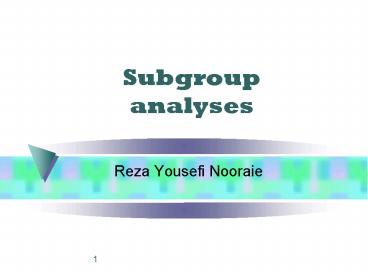Subgroup analyses PowerPoint PPT Presentation
1 / 25
Title: Subgroup analyses
1
Subgroup analyses
- Reza Yousefi Nooraie
2
Subgroup analyses
- To compare effect estimates in different
subgroups by considering the meta-analysis
results from each subgroup separately.
3
(No Transcript)
4
Attention!
- Either the effect or the test for heterogeneity
in one subgroup is statistically significant
whilst that in other subgroup is not does not
indicate that the subgroup factor explains
heterogeneity.
5
Is the effect different in different subgroups?
- Comparing the subgroups with each other
6
Meta-regression
7
Meta-regression
- If studies are divided into subgroups this may be
viewed as an investigation of how a categorical
study characteristic is associated with the
treatment effects in the meta-analysis.
8
- Meta-regression is an extension to subgroup
analyses - allows the effect of continuous, as well as
categorical, characteristics to be investigated,
and allows the effects of multiple factors to be
investigated simultaneously
9
Meta-regression
- Multivariate approach
- Use the study characteristics as independent
variables - Design, age, population source, quality score etc
etc - Use effect size or other outcome as the dependent
variable - Identify significant study characteristics
- Unit of observation study
- Can be useful to identify sources of
heterogeneity, clarify importance of quality
scores
10
- Meta-regression should generally not be
considered when there are fewer than 10 trials in
a meta-analysis.
11
Meta VS MultipleREGRESSION
- Meta-regressions are similar in essence to
multiple regressions, in which an outcome
variable is predicted according to the values of
one or more explanatory variables.
12
Meta VS MultipleREGRESSION
- Differences
- Larger studies have more influence on the
relationship than smaller studies, since studies
are weighted by the precision of their respective
effect estimate. - It is wise to allow for the residual
heterogeneity among treatment effects not
modelled by the explanatory variables.
13
- The regression coefficient
- describe how the outcome variable changes with a
unit increase in the explanatory variable - The statistical significance of the regression
coefficient - whether there is a linear relationship between
treatment effect and the explanatory variable.
14
For study subgroups
- The regression coefficients will estimate how the
treatment effect in each subgroup differs from a
reference subgroup. - The P-value of each regression coefficient will
indicate whether this difference is statistically
significant.
15
Meta-regression Example(Phillips 1991 26 HIV
studies, Dependent var Specificity)
16
When do a Meta-regression
- Ensure that there are adequate studies to justify
meta-regressions - It is very unlikely that an investigation of
heterogeneity will produce useful findings unless
there is a substantial number of studies. - at least ten observations (i.e. ten studies in a
meta-analysis) should be available for each
characteristic modelled.
17
When do a Meta-regression
- Specify characteristics in advance
- Reviewers should, whenever possible, pre-specify
characteristics in the protocol that later will
be subject to subgroup analyses or
meta-regression.
18
When do a Meta-regression
- Select a small number of characteristics
- The likelihood of a false positive result among
subgroup analyses and meta-regression increases
with the number of characteristics investigated.
19
When do a Meta-regression
- Ensure there is scientific rationale for
investigating each characteristic - Selection of characteristics should be motivated
by biological and clinical hypotheses, ideally
supported by evidence from sources other than the
included studies.
20
When do a Meta-regression
- Be aware that the effect of a characteristic may
not always be identified - Many characteristics that might have important
effects on how well an intervention works cannot
be investigated using meta-regression. - These are characteristics of participants that
might vary substantially within studies, but
which can only be summarised at the level of the
study.
21
An Example
- Consider a collection of clinical trials
involving adults ranging from 18 to 60 years old.
- There may be a strong relationship between age
and treatment effect that is apparent within each
study. - However, if the mean ages for the trials are
similar, then no relationship will be apparent by
looking at trial mean ages and trial-level effect
estimates. - The problem is one of aggregating individuals
results and is variously known as aggregation bias
22
When do a Meta-regression
- Think about whether the characteristic is closely
related to another characteristic (confounded) - Two characteristics are confounded if their
influences on the treatment effect cannot be
disentangled - Computing correlations between trial
characteristics
23
An Example
- If those studies implementing an intensive
version of a therapy happened to be the studies
that involved patients with more severe disease
24
- Relationship between treatment effect and a
single covariate
25
- A scatter plot with the covariate along the
horizontal axis and the treatment effect along
the vertical axis
26
(No Transcript)

